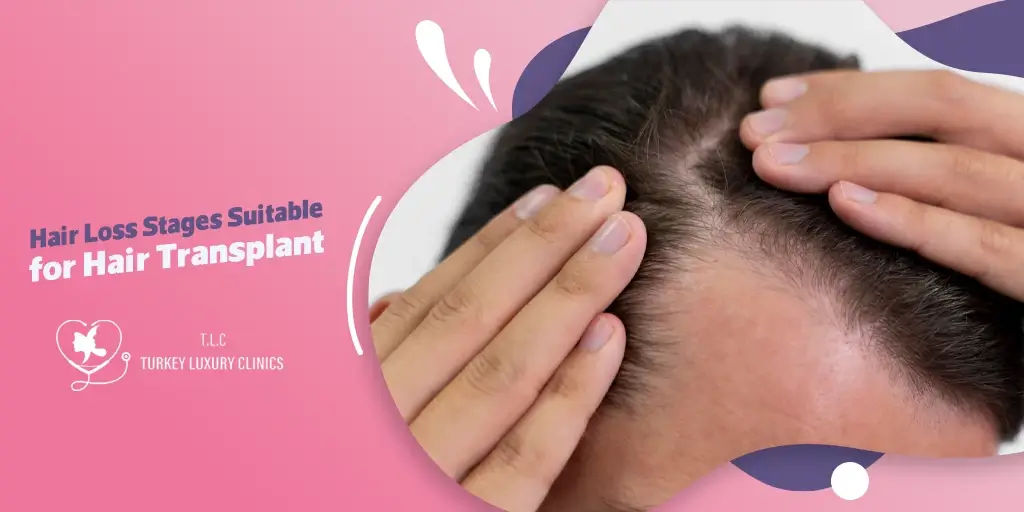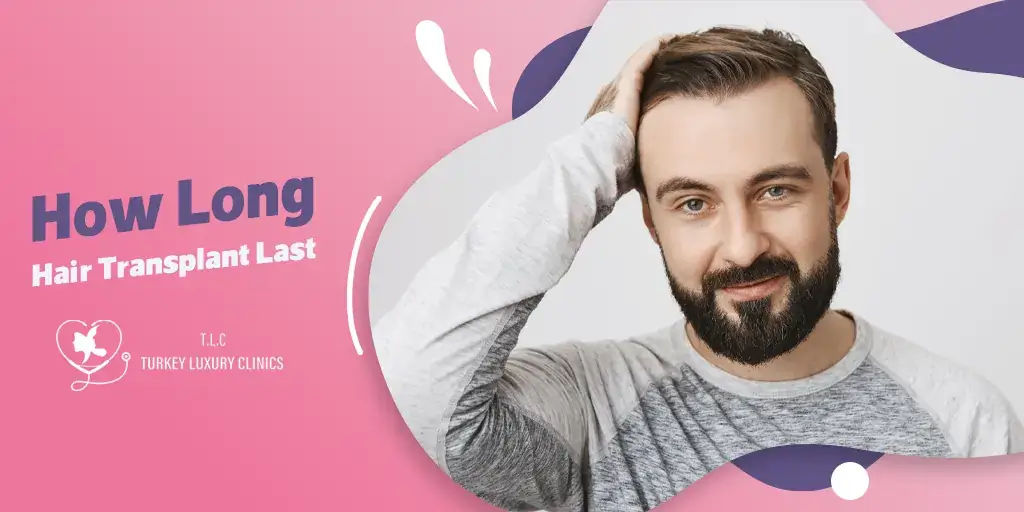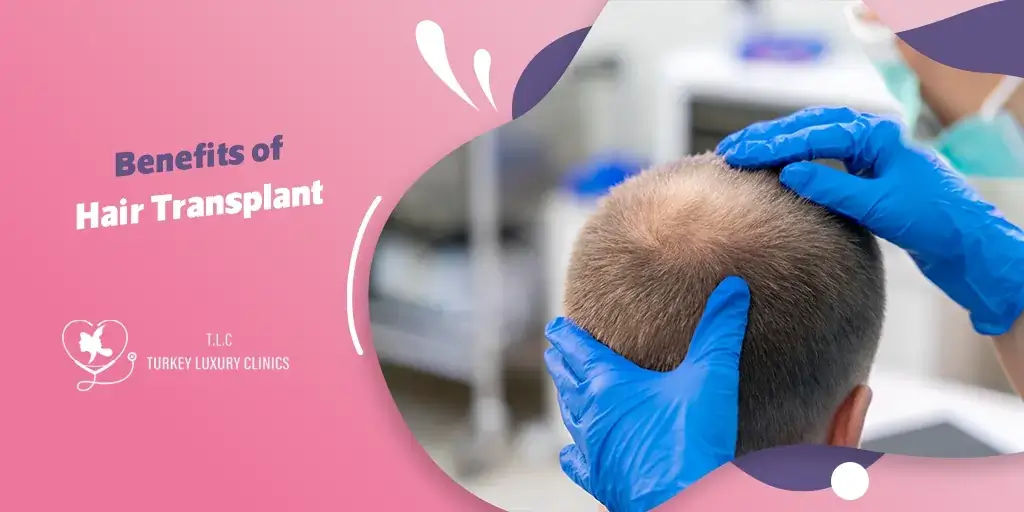- - What are the Hair Loss Stages?
- - Male Pattern Hair Loss Stages (Norwood Stages of Hair Loss)
- - Female Pattern Hair Loss Stages
- - Stages of Hair Loss Female: Ludwig Scale Stages Explained
- - Chemotherapy Hair Loss Stages
- - Treatment Options By Hair Loss Stage
- - When to Consider a Hair Transplant for Hair Loss?
- - Get Expert Help for Your Hair Loss Stage at Turkey Luxury Clinics
- - Sources
Hair loss often develops gradually in clearly defined stages—and identifying your stage is key to choosing the right treatment.
Whether you're dealing with male pattern baldness or female hair thinning, the Norwood and Ludwig scales help classify hair loss and guide treatment decisions.
In this article, we explain the stages of hair loss using the Norwood and Ludwig scales, explore the best treatments for each stage, and highlight when a hair transplant becomes the ideal solution.
Looking for personalized advice? At Turkey Luxury Clinics, we connect you with top hair specialists and transplant surgeons to assess your stage and choose the most effective solution.
What are the Hair Loss Stages?
Hair loss stages are typically categorized using the Norwood scale for men and the Ludwig scale for women. The Norwood stages of hair loss has seven stages, ranging from no visible hair loss to severe baldness. The Ludwig scale has three stages, focusing on thinning hair at the crown and widening of the hair part.
In most cases, hair loss doesn’t happen overnight or within just a few days. It usually develops gradually over time, depending on the cause and type of hair loss.
For example, male pattern baldness can take years to progress, and usually occurs as 7 stages hair loss showing a distinct V- or M-shaped thinning pattern. In contrast, hair loss caused by chemotherapy tends to happen more quickly—usually after the first or second treatment cycle—and appears in a more scattered, patchy way.
Male Pattern Hair Loss Stages (Norwood Stages of Hair Loss)
Male pattern baldness - Androgenetic Alopecia - typically develops slowly over the years, although it may begin as early as the late teens or early 20s.
The rate and severity of progression can vary widely, depending on genetics, hormones, and individual response to treatment.
Norwood scale classifies Hair loss stages in male pattern baldness into 7 stages of hair loss.
Norwood Scale Stages and the 7 Stages of Hair Loss
Stage I (Stage 1 hair loss): This is the earliest stage, with no visible bald patches—just mild hair shedding.
Stage II (Stage 2 hair loss): During hair loss stage 2, the hair begins to form a V-shaped pattern at the front hairline or temples, where thinning becomes noticeable.
Stage III (Stage 3 hair loss): The temples continue to thin significantly, and mild thinning may start to appear at the crown of the head.
Stage IV (Stage 4 hair loss): Baldness progresses at both the temples and crown, creating a characteristic horseshoe-shaped pattern across the front and top of the scalp.
Stage V (Stage 5 hair loss): The bald areas at the temples and crown enlarge, with only a narrow band of hair remaining between them.
Stage VI (Stage 6 hair loss): Hair is lost from the front and top of the head, leaving limited hair only on the sides and back.
Stage VII (Stage 7 hair loss): The most advanced stage of male pattern baldness, with severe hair loss except for a horseshoe-shaped band of hair remaining around the sides and back of the scalp
Female Pattern Hair Loss Stages
Female pattern baldness, also known as androgenetic alopecia, is a common condition characterized by hair thinning, primarily on the top and crown of the scalp.
Female hair loss stages do not involve a receding hairline. Instead, it presents as progressive thinning and increased hair shedding — often starting in adulthood.
The stages of female hair loss are usually divided into three levels of severity, helping doctors tailor treatment based on how much thinning has occurred.
The rate and severity of hair loss can vary based on genetics, hormonal changes, and how the body responds to treatment.
To assess the extent of thinning, the Ludwig scale is commonly used. It classifies female pattern baldness into three main stages based on hair density at the crown and top of the scalp.
Stages of Hair Loss Female: Ludwig Scale Stages Explained
Stage I: Mild thinning at the top of the scalp. Hair loss may be minimal and not immediately noticeable.
Stage II: Moderate thinning becomes apparent, especially around the crown, with visible reduction in hair density.
Stage III: Significant thinning and more severe hair loss at the crown and top of the scalp, often leaving the scalp visibly exposed.
Chemotherapy Hair Loss Stages
Hair loss from chemotherapy typically begins 2 to 4 weeks after starting treatment. The chemo hair loss stages, pattern and severity depend on the type of chemotherapy, dosage, and individual response.
Hair usually falls out gradually, rather than suddenly, and typically in clumps, and patients often notice it on their pillow, in the shower drain, or when using a comb or brush. Hair loss can appear as general thinning, patchy bald spots, or complete baldness.
Shedding usually continues throughout the course of treatment and may persist for a few weeks after it ends.
Talk to your oncologist to understand what kind of hair loss you can expect based on your chemo regimen and how to prepare for it.
Treatment Options By Hair Loss Stage
Choosing the best treatment for hair loss—whether it’s male pattern baldness or female pattern hair thinning—depends largely on the stage of progression. Hair loss in men is typically classified using the Norwood Scale (Stages 1 to 7), while female hair loss follows the Ludwig Scale (Stages I to III).
1. Treatment of Early Stages of Hair Loss (Norwood Stages 1 & 2 / Ludwig Stage I)
In the early stages, hair loss is usually mild and can often be managed with non-invasive treatments:
- Minoxidil topical solution, which helps prolong the growth phase of hair.
- Low-Level Laser Therapy (LLLT) to improve blood flow and follicle stimulation.
These options may delay further shedding and encourage new hair growth. However, individual results vary based on genetics, hormonal balance, and consistent use.
2. Treatment of Mid Stages of Hair Loss (Norwood Stages 3–5 / Ludwig Stage II)
Hair thinning becomes more noticeable, especially around the temples and crown (in men) or the top of the scalp (in women). Effective treatments at this stage include:
- PRP (Platelet-Rich Plasma) therapy and stem cell therapy to boost follicle activity.
- Combination therapy, such as minoxidil with anti-androgens (especially for women).
- Hair transplant surgery becomes a viable option, especially for patients over 25 whose hair loss has stabilized.
Read more about: Hair Transplant For Thinning Hair
3. Treatment of Late Stages of Hair Loss (Norwood Stages 6 & 7 / Ludwig Stage III)
At this point, hair loss is advanced and visible across large areas of the scalp.
- Hair transplantation is often the most effective solution, involving the relocation of hair follicles from donor areas to balding zones.
- In cases with insufficient donor hair, alternative solutions such as scalp micropigmentation or cosmetic hair systems may be considered.
When to Consider a Hair Transplant for Hair Loss?
Are you qualified for hair transplant? A hair transplant becomes a suitable option when hair loss has stabilized—meaning shedding has slowed and the pattern of baldness is more predictable.
This typically occurs after age 25, often in the late 20s to early 30s, though it may vary depending on genetics and health factors.
It’s usually recommended in the mid to late stages of hair loss (Norwood stages 3–7 for men, or Ludwig stage II–III for women), especially when non-surgical treatments like minoxidil, finasteride, or PRP are no longer effective.
The success of a hair transplant also depends on having a sufficient amount of healthy donor hair—usually from the back or sides of the scalp. A consultation with a qualified hair restoration specialist is essential to determine your eligibility and expected outcome.
Interesting reads: Types of Hair Transplant Procedures
Get Expert Help for Your Hair Loss Stage at Turkey Luxury Clinics
Worried about hair loss and not sure what to do? Discovering the stage and cause of your condition is the first step toward effective treatment. At Turkey Luxury Clinics, our experts assess your case and guide you through proven treatments. If you're a candidate, a hair transplant may offer a permanent solution and help restore your natural, confident look.
Turkey Luxury Clinics












.webp)
.webp)
.webp)
.webp)

